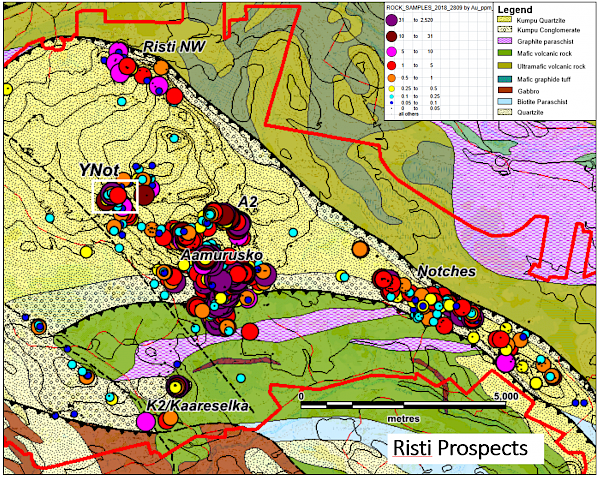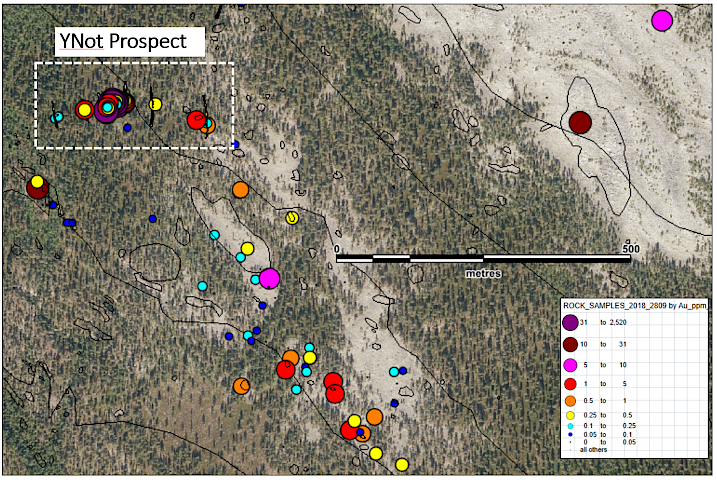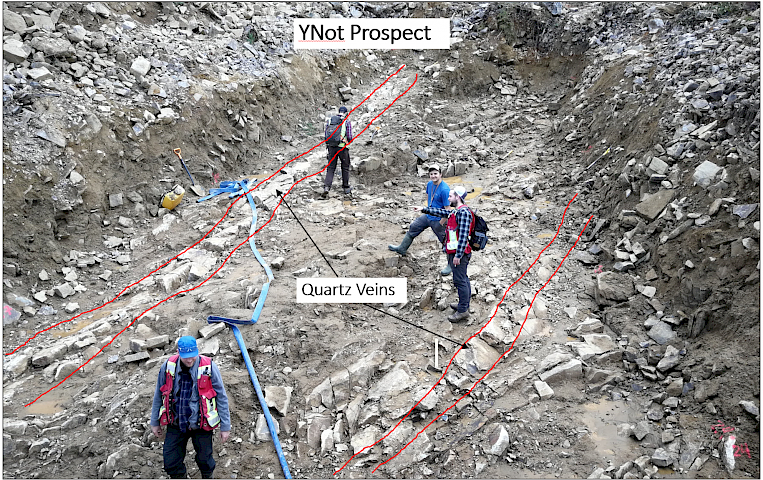Aurion Makes New High Grade Surface Discovery at Risti
Aurion Resources Ltd. (TSX VENTURE:AU) (“Aurion” or the “Company”) is pleased to report that a new zone of gold mineralization has been discovered in bedrock at Risti.
The “YNot” Prospect is located approximately 3.6 km Northwest of Aamurusko and comprises an east-west trending zone of quartz veins and associated extensional/stockwork veining hosted by siliceous sandstone.
Mechanical trenching has exposed a zone of quartz vein hosted gold mineralization in bedrock up to 10 m wide over a distance of 260 m, open in both directions. Individual quartz veins are up to 1.0 m wide and numerous 1 cm to 10 cm wide extensional quartz veins occur peripherally to the larger shear veins. They are variably mineralized with pyrite, chalcopyrite, iron oxides and locally coarse visible gold.
A total of 39 surface rock chip or grab samples collected from angular boulders assayed from nil to 705.0 g/t Au including 10 samples that assayed greater than 5.0 g/t Au. The average grade of all samples was 30.77 g/t Au and the median grade was 0.68 g/t Au (i.e., half the samples assayed higher and half assayed lower than the median grade). Grab samples of angular boulders assaying 23.9 and 23.5 g/t Au were also discovered approximately 180 and 750 m Southwest and East of YNot trenches, respectively. Note that grab samples are selective and thus are not necessarily representative of the mineralization hosted elsewhere on the property.
Assays are pending for approximately 80 saw-cut channel samples.
Maps and photos can be found attached or on Aurion’s website by clicking the following link, https://aurionresources.com/site/assets/files/1255/nr021018figures.pdf.
Discussion
The discovery of a new zone of auriferous quartz veining in bedrock through trenching of boulders continues to support that glacial dispersion of boulders is minimal at the Risti Project. Moreover, the identification of gold mineralization associated with another east-west trending structure suggests the presence of multiple parallel mineralized structures. The discovery of mineralization >3.5 km Northwest of Aamurusko indicates a large scale mineralizing system is present at Risti. The average grade of more than 3,500 rock samples collected across the Risti project is > 10 g/t Au.
2018 Program Details
Drilling at Aamurusko has been underway since early July and continues with two drills. Initial plans include completing 15,000 m. Assays are pending for 23 drillholes.
Trenching with two excavators continues throughout the property as well.
Structural and lithological mapping is being conducted in conjunction with a detailed UAV magnetic survey.
Prospecting with a team of 6 prospectors continues to add significant value. Only 25% of the 15,000 ha Risti property has been systematically prospected.
Aurion is currently hosting an analyst/investor tour.
Aurion has approximately C$16 million cash in the treasury and is well funded to advance the Aamurusko discovery and the Risti Project into the foreseeable future.
Background
The geological setting of the Risti project has many similarities to prolific gold-rich orogenic gold belts globally, specifically the Timmins camp of the Abitibi province of Northern Ontario. The Aamurusko zone appears to be underlain by young unconformable clastic rocks (meta-sandstones and conglomerates) of the Kumpu Group. These Kumpu Group conglomerates resemble the Timiskaming conglomerates of the Timmins and Kirkland Lake area of the Abitibi province and occur in a similar geo-tectonic setting (both represent the youngest stratigraphic sequence within their respective belts). The Kumpu Group and the Timiskaming group were deposited in late orogenic extensional basins. They form in relation to major movement along regional faults or deformation zones. In the Abitibi province, many high-grade, multimillion-ounce gold deposits are temporally and spatially associated with the Timiskaming conglomerates (or their equivalents) in close proximity to major regional deformation (fault) zones such as the Porcupine-Destor or Cadillac Lake-Larder Lake deformation zones. The Kumpu Group appears to have been deposited in a similar geological setting adjacent to the Sirkka shear zone, which is a major deformation zone in the Central Lapland Greenstone Belt. Strong alteration including fuchsite, tourmaline, iron carbonate, albite and quartz veining is seen along the entire length of this structure.
Quality Assurance and Quality Control
All samples were delivered to ALS Minerals preparation facility in Sodankyla, Finland where sample preparation work was completed. All analytical work was completed at ALS Minerals facility in Loughrea, Ireland. ALS Minerals is an internationally accredited lab and are ISO compliant (ISO 9001:2008, ISO/IEC 17025:2005). All samples were analyzed for gold using the Au-AA26 procedure (50g fire assay with AAS finish: Lower Detection Limit 0.01 g/t gold; Upper Limit – 100 g/t gold). Any samples that returned overlimit values (>90.0 g/t gold) or had visual indication of mineralization, such as visible gold or prospective vein intervals (>90.0 g/t gold) were analyzed by Au-SCR24 1kg, Screen Fire Assay Au (0.05-1,000 ppm) by 1kg screen fire assay (50g nominal sample weight). The sample pulp (1kg) is passed through a 100 micron stainless steel screen. Any material remaining on the screen (>100 micron) is retained and analyzed in its entirety by fire assay with gravimetric finish and reported as the Au (+) fraction. The material passing through the screen (<100 micron) is homogenized and two sub-samples are analyzed by fire assay with AAS finish. The average of the two AAS results is taken and reported as the Au (-) fraction result. All three values are used in calculating the combined gold content of the plus and minus fractions. The gold values for both the (+) 100 and (-) 100 micron fractions are reported together with the weight of each fraction as well as the calculated total gold content of the sample.) Multi-element analysis (ME-ICP61, four-acid digestion, 35 element ICP-AES) was completed on all samples. Certified standards and blanks were inserted every 30 samples. ALS has its own QA/QC protocol using standards, blanks and duplicates.
Mike Basha, P.Eng., P.Geo., President and CEO of Aurion, a Qualified Person as defined by National Instrument 43-101, is responsible for the preparation of this release. For more information on these projects please visit our website at www.aurionresources.com.
Forward-Looking Statement
ertain statements contained in this release constitute forward-looking information. These statements relate to future events or future performance. The use of any of the words “could”, “intend”, “expect”, “believe”, “will”, “projected”, “estimated” and similar expressions and statements relating to matters that are not historical facts are intended to identify forward-looking information and are based on the Companies’ current belief or assumptions as to the outcome and timing of such future events. Actual future results may differ materially. The forward-looking information contained in this release is made as of the date hereof and Aurion is not obligated to update or revise any forward‑looking information, whether as a result of new information, future events or otherwise, except as required by applicable securities laws. Because of the risks, uncertainties and assumptions contained herein, investors should not place undue reliance on forward‑looking information. The foregoing statements expressly qualify any forward‑looking information contained herein.
On behalf of the Board of Directors,
Michael Basha, Chief Executive Officer
Neither the TSX Venture Exchange nor its Regulation Services Provider (as that term is defined in the policies of the TSX Venture Exchange) accepts responsibility for the adequacy or accuracy of this release.







